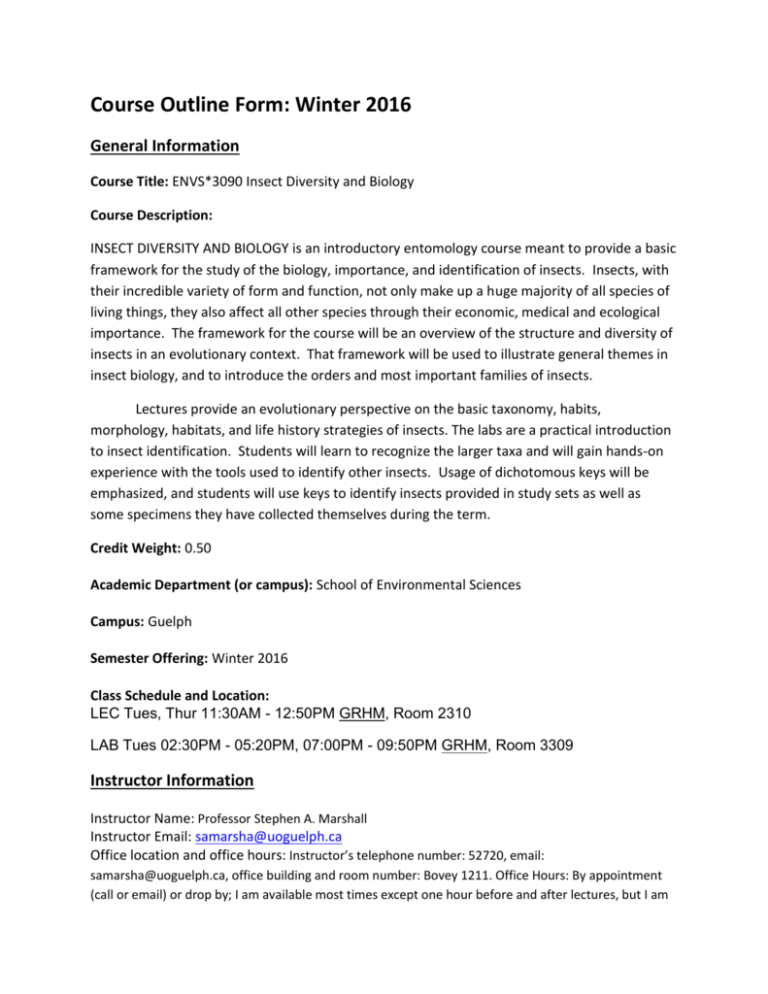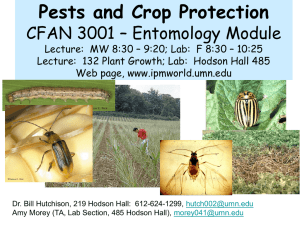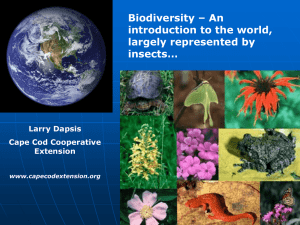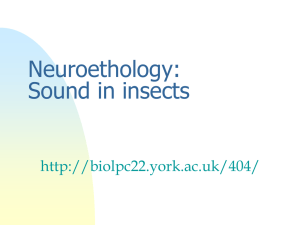ENVS*3090 Insect Diversity and Biology
advertisement

Course Outline Form: Winter 2016 General Information Course Title: ENVS*3090 Insect Diversity and Biology Course Description: INSECT DIVERSITY AND BIOLOGY is an introductory entomology course meant to provide a basic framework for the study of the biology, importance, and identification of insects. Insects, with their incredible variety of form and function, not only make up a huge majority of all species of living things, they also affect all other species through their economic, medical and ecological importance. The framework for the course will be an overview of the structure and diversity of insects in an evolutionary context. That framework will be used to illustrate general themes in insect biology, and to introduce the orders and most important families of insects. Lectures provide an evolutionary perspective on the basic taxonomy, habits, morphology, habitats, and life history strategies of insects. The labs are a practical introduction to insect identification. Students will learn to recognize the larger taxa and will gain hands-on experience with the tools used to identify other insects. Usage of dichotomous keys will be emphasized, and students will use keys to identify insects provided in study sets as well as some specimens they have collected themselves during the term. Credit Weight: 0.50 Academic Department (or campus): School of Environmental Sciences Campus: Guelph Semester Offering: Winter 2016 Class Schedule and Location: LEC Tues, Thur 11:30AM - 12:50PM GRHM, Room 2310 LAB Tues 02:30PM - 05:20PM, 07:00PM - 09:50PM GRHM, Room 3309 Instructor Information Instructor Name: Professor Stephen A. Marshall Instructor Email: samarsha@uoguelph.ca Office location and office hours: Instructor’s telephone number: 52720, email: samarsha@uoguelph.ca, office building and room number: Bovey 1211. Office Hours: By appointment (call or email) or drop by; I am available most times except one hour before and after lectures, but I am normally in the insect collection (1216 Bovey) rather than my office. The GTAs can usually be found in the insect collection/systematics lab. GTA Information GTA Name: GTA Email: GTA office location and office hours: Course Content This course is a general introduction to entomology with an emphasis on insect diversity. Lectures provide an evolutionary perspective on the basic taxonomy, habits, morphology, habitats, and life history strategies of insects. Students will be expected to attain some fluency in the language of entomology, showing an understanding of basic insect structure and the overall diversity of the Insecta. They will learn to extrapolate from general patterns of life history and behavior to specific predictions about the biology of most of the animals encountered in terrestrial and freshwater environments. The laboratories will work synergistically with the lectures to reinforce recognition of large and important taxa (orders, families) and to identify other taxa using dichotomous keys. In both the lecture and the laboratory the emphasis will be on the attainment of practical skills needed by teachers, naturalists, and field biologists in a variety of related disciplines. Specific Learning Outcomes: Practical understanding of basic insect structure and function Practical understanding of the basics of insect taxonomy Familiarity with the biology of all insect orders and the main families of insects Familiarity with the basics of insect phylogeny and the relationships of major groups Recognition of how particular insect groups impact humanity for better or for worse Ability to make statements about insect taxa at an appropriate level of generality Ability to identify common or important groups of insects Ability to use identification tools (keys) Lecture Content: Lecture sequence (text reference pages in parentheses) 01) What is an insect? What are we going to cover in this course? Basic morphology. (1-13) 02) More morphology, higher classification and phylogeny, and introduction to the "Apterygota" (14 – 17). 03) The origin of wings and the main lineages of winged insects. Dragonflies and mayflies. (19-22, 2733). 04) Introduction to the Neoptera: Plecoptera and the orthopteroid insects (52, 53, 58-65) 05) Orthoptera and an introduction to the hemipteroid orders (71-75) 06) True bugs one – aquatic Heteroptera plus (91-100). 07) True bugs two – terrestrial Heteroptera and the “homopteran” suborders. (101-110). 08) Booklice, lice, and disease (110-111). 09) Metamorphosis and caddisflies (161, 237-240). 10) Lepidoptera one – butterflies, microlepidopterans and silkworms (162-172) Mid term 11) Lepidoptera – Gypsy moths, tent caterpillars, cutworms and other macromoths (172-179). 12) Beetles one: Structure, diversity, higher classification and the Adephaga 13) Beetles two: Aquatic beetles (257- 264) 14) Beetles three: Polyphaga continued (264-278) 15) Beetles four: “the Phytophaga” from leaf beetles to bark beetles. 16) Odd orders - Strepsiptera and Megaloptera (279-284, 251), scorpionflies, snakeflies, nerve-winged insects, and fleas (247-251, 421-424). 17) Diptera – introduction and the “lower Diptera” (381-383 & 391-394). 18) Biting flies and disease (384-390). 19) The lower Brachycera and Aschiza (395-405) 20) The Schizophora (405-421) 20) Parasites, kleptoparasites and parasitoids. 21) Hymenoptera 1: Sawflies and parasitoids (518-526). 22) Hymenoptera 2: Ants, wasps and bees (527-536). 23) Catch-up, review, and overview. Labs: Most laboratory time will be spent learning to recognize the common orders and families of hexapods. By the end of the course you should be able to recognize all hexapods to the level of order, and you will be able to identify most to the family level. Each lab is based on a “study box” containing specimens of each group you are required to learn. The bottom of each study box has a branching, illustrated key with specimens pinned into the box at the appropriate point in the key. The keys are simplified versions of those in the back of your textbook, emphasizing only those families that you need to learn to recognize for this course. The textbook keys also include many relatively small or uncommon insect families that you are not expected to recognize. To identify a specimen that you do not recognize, or to confirm that you are correctly recognizing a family, follow through the key until you reach a name. Be sure and handle the pinned specimens with care, as they are fragile. Position the specimen on a cork or a bit of modeling clay under your microscope rather than trying to manipulate the pin in your fingers. Live material will be brought into the lab when possible, and you are encouraged to bring in your own live specimens as you prepare your own small insect collection. The insect collection, worth 15%, will include only 15 specimens, of which a maximum of 5 are to be submitted in vials of ethanol (provided) and the balance to be pinned (pins and a box will be provided in the lab). Up to 5 of the 15 specimens may be alternatively submitted as a single page of printed digital images but they must be labeled properly, certified as your own images, and based on specimens examined and identified by you. Specimens must be properly labeled and identified for full marks. Further instructions for the collection can be found in your text and will be provided in the lab. Lab testing procedure Lab tests in this course are “bell ringers” in which you will receive two specimens, or a specimen and a question, every few minutes. Specimens are to be identified to family if possible, otherwise to order, giving both scientific and common names. Written questions will usually probe your knowledge of the general biology of the family of insects in front of you. You are responsible for learning the biology of each family from lectures, lecture notes or the text. Course Assignments and Tests: Assignment or Test Due Date Contribution to Final Mark (%) 20 Midterm lecture exam, in class Feb 25 Lab tests Jan 26, Feb 23, Mar 16, Mar 29 5%, 10%, 10%, 15% Insect collection April 5 15% Learning Outcomes Assessed Understand the relationships, habits, morphology, habitats, and life history strategies of insects Identify insects and link those identifications to lecture material Using keys to discover local biodiversity Assignment or Test Due Date Final exam TBA Contribution to Final Mark (%) 25% Learning Outcomes Assessed Understand the economic and medical significance, relationships, and life history strategies of insects NOTE: LAB EXAMS INCORPORATE BOTH LECTURE AND LABORATORY MATERIAL Missed midterm exams: If the midterm exam is not written at the scheduled date and time then weighting will be transferred to other course components. Missed lab tests: Missed lab tests will normally result in a mark of zero for that component. There are no alternate lab tests. If appropriate documentation is provided prior to the last laboratory section weighting will be transferred from a missed test to other course components. Late assignments: The lab assignment (insect collection) must be submitted during your scheduled lab period on the due date, April 5. Failure to submit the assignment by that time will result in a zero grade for the assignment unless extenuating circumstances are properly documented through your program counselor. Final examination date and time: Final exam weighting: 25% Course Resources Required Texts: Insects: Their Natural History and Diversity - S.A. Marshall. Firefly Books (2006). (ISBN 1552979008) was written with this course in mind and the lectures correspond closely with the text. (Borror and Delong’s Introduction to the Study of Insects” is an acceptable alternative. You will need one of these two books; the library call number for the text is QL473 .M33 2006, Borror and Delong is at QL463 .B69 2004 ). Lab Manual: Pp 615-667 of your text can be used as a lab manual. Simplified versions of the lab specimen keys are posted on CourseLink and further resources are available in the laboratory. Other Resources: Although the textbook is followed closely, the CourseLink site provides a useful forum for updates, interesting links and post-lecture addenda, as well as a convenient repository for general information about the course. Please note: Students must use their University of Guelph central login ID (e-mail account) and password to log on to CourseLink. If you forget your password, contact Computing and Communication Services. OTHER RESOURCES: Check out the website for the University of Guelph Insect Collection (http://www.uoguelph.ca/debu/) for further useful resources and links. Course Policies Grading Policies: Missed midterm exams: If the midterm exam is not written at the scheduled date and time then weighting will be transferred to other course components. No alternate midterms will be offered. Missed lab tests: Missed lab tests will normally result in a mark of zero for that component. There are no alternate lab tests. If appropriate documentation is provided prior to the last laboratory section weighting will be transferred from missed tests to other course components. Late assignments: The lab assignment (insect collection) must be submitted during your scheduled lab period on the due date. Course Policy regarding use of electronic devices and recording of lectures: Electronic recording of classes is expressly forbidden without consent of the instructor. When recordings are permitted they are solely for the use of the authorized student and may not be reproduced, or transmitted to others, without the express written consent of the instructor. University Policies Academic Consideration: The University of Guelph is committed to supporting students in their learning experiences and responding to their individual needs and is aware that a variety of situations or events beyond the student's control may affect academic performance. Support is provided to accommodate academic needs in the face of personal difficulties or unforeseen events in the form of Academic Consideration. Information on regulations and procedures for Academic Consideration, Appeals and Petitions, including categories, grounds, timelines and appeals can be found in Section VIII (Undergraduate Degree Regulations and Procedures) of the Undergraduate Calendar. Academic Misconduct: The University of Guelph is committed to upholding the highest standards of academic integrity and it is the responsibility of all members of the University community, faculty, staff, and students to be aware of what constitutes academic misconduct and to do as much as possible to prevent academic offences from occurring. University of Guelph students have the responsibility of abiding by the University's policy on academic misconduct regardless of their location of study; faculty, staff and students have the responsibility of supporting an environment that discourages misconduct. Students need to remain aware that instructors have access to and the right to use electronic and other means of detection. Please note: Whether or not a student intended to commit academic misconduct is not relevant for a finding of guilt. Hurried or careless submission of assignments does not excuse students from responsibility for verifying the academic integrity of their work before submitting it. Students who are in any doubt as to whether an action on their part could be construed as an academic offence should consult with a faculty member or faculty advisor. Detailed information regarding the Academic Misconduct policy is available in Section VIII (Undergraduate Degree Regulations and Procedures) of the Undergraduate Calendar. Accessibility: The University of Guelph is committed to creating a barrier-free environment. Providing services for students is a shared responsibility among students, faculty and administrators. This relationship is based on respect of individual rights, the dignity of the individual and the University community's shared commitment to an open and supportive learning environment. Students requiring service or accommodation, whether due to an identified, ongoing disability or a short-term disability should contact the Student Accessibility Services (SAS), formerly Centre for Students with Disabilities (CSD), as soon as possible. For more information, contact SAS at 519-824-4120 ext. 56208 or email sas@uoguelph.ca or visit the Student Accessibility Services website (http://www.uoguelph.ca/csd/). Course Evaluation Information: End of semester course and instructor evaluations provide students the opportunity to have their comments and opinions used as an important component in the Faculty Tenure and Promotion process, and as valuable feedback to help instructors enhance the quality of their teaching effectiveness and course delivery. While many course evaluations are conducted in class others are now conducted online. Please refer to the Course and Instructor Evaluation Website for more information. Drop period: The drop period for single semester courses starts at the beginning of the add period and extends to the Fortieth (40th) class day of the current semester (the last date to drop a single semester courses without academic penalty) which is listed in Section III (Schedule of Dates) of the Undergraduate Calendar. The drop period for two semester courses starts at the beginning of the add period in the first semester and extends to the last day of the add period in the second semester. Information about Dropping Courses can be found in Section VIII (Undergraduate Degree Regulations and Procedures) of the Undergraduate Calendar. Additional Course Information None








